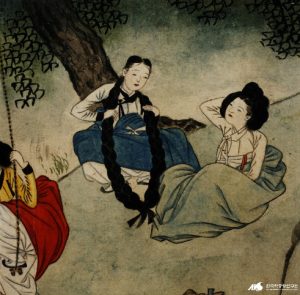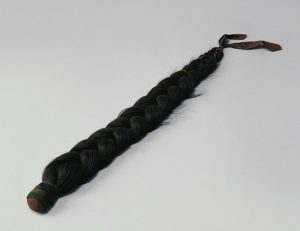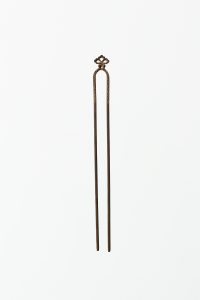For centuries across all cultures, women have been altering their hair in order to make themselves beautiful. During the Three Kingdoms period and through Goryeo to early Joseon, ladies, rich and poor, would use 가체 – gache, or hair pieces, to create elaborate hairstyles (Lee 147).
These pieces were so precious and expensive that some brides could not greet their in-laws after the wedding because they couldn’t afford their gache (ibid. 197). It was customary for the in-laws to provide the bride with the hair pieces for the wedding and she needed them to greet her new in-laws right after getting married.
다리 – dari, is a hairstyle where you twist the braided gache on top of your head. As with many trends, the dari hairstyle got more extravagant as time passed. Eventually, the hairstyle got to half a foot tall off of the head and was adorned with gems, silks, and pins (ibid. 198).
In 1757, King Yeongjo set out to ban the extravagant hairstyle, but people resisted and continued wearing their hair the same way. In 1788, King Jeongjo set strict rules on how people could wear their hair, even restricting wearing your natural hair in the same fashion as dari (ibid. 200). From the Joseon Annals, he said:
There aren’t any perfect laws in this world and there aren’t any laws that will satisfy all sides. But I believe that this ban is an exception to the rule. Isn’t it a perfect law since it will take us from extravagance to frugality? A barbarian custom is replaced by a civilized one, so doesn’t this satisfy all sides? Is there anything about wearing dari in the book of etiquette or the code of laws? If one considers the origins of dari, one realizes that it is not a beautiful custom. What started as a way to neatly arrange a woman’s hair has turned into an unwieldy hairstyle, which is something of a drag on the wearer. And as everyone made their wigs big, the price of wigs went up. People given to extravagance did not even care about going bankrupt; poor people reached a point where they were not able to wed because they could not afford the expensive wigs. It is important to put an end to this detestable practice. So don’t tell me that women’s fashion has nothing to do with government affairs. (The Annals of Jeongjo, Year 12)
After the ban on gache and dari were in place, people were only allowed to wear extravagant hairstyles on their weddings. For unmarried girls, a single long braid was worn down the back. For married women, a bun held with a 비녀 – binyeo was to be the hairstyle of choice. From here on out, the stick binyeo became widespread (Lim). Previous to the stick 잠비녀 – jambinyeo, U-shaped 채비녀 chaebinyeo were used to decorate and affix hairstyles.
For my first attempt at Korean garb in the SCA, I’ll be attempting a Goryeo period dress and hairstyle. Since the stick binyeo is from the eighteenth century, I should be using the U-shaped binyeo and gache.
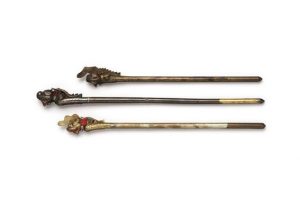
잠비녀 – jambinyeo – Late Joseon
Making my gache
They would have used real hair for their gache pieces, but real hair is expensive and since I’m going to be wearing my hairpieces to events and camping, I’m not going to spend a lot of money of a piece that I’ll be sweating in. I purchased some kanekalon from Sally’s Beauty Supply for about 3 dollars a pack. My hair is a very dark brown, so I bought two packs of color 4 and two packs of color 2 to mix.
I used 2 packs for one braid. I mixed the colors by laying the two bundles on top of each other and splitting them apart. It got messy quickly, but I did my best to keep it together. I brushed the colors together to mix the strands.
I tied off one end and braided the hair into one long braid. The kanekalon hair has a texture that helps it grip, but it also makes it a little frizzy. There are ways to steam the hair to make it smoother, but I didn’t bother to try. The frizziness doesn’t bother me as much as I thought it would.
After making a braid, I tried it on my head:
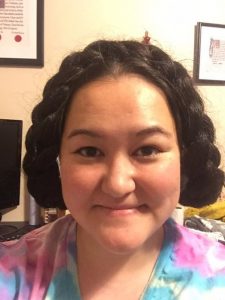
One braid on my head
It didn’t give me the fullness I was expecting so I used both braids and tried wrapping them around my head:
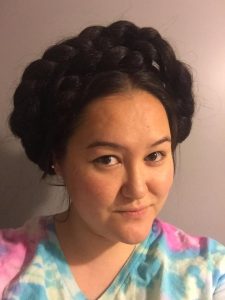
Two braids wrapped around
This had more of the effect I was going for!
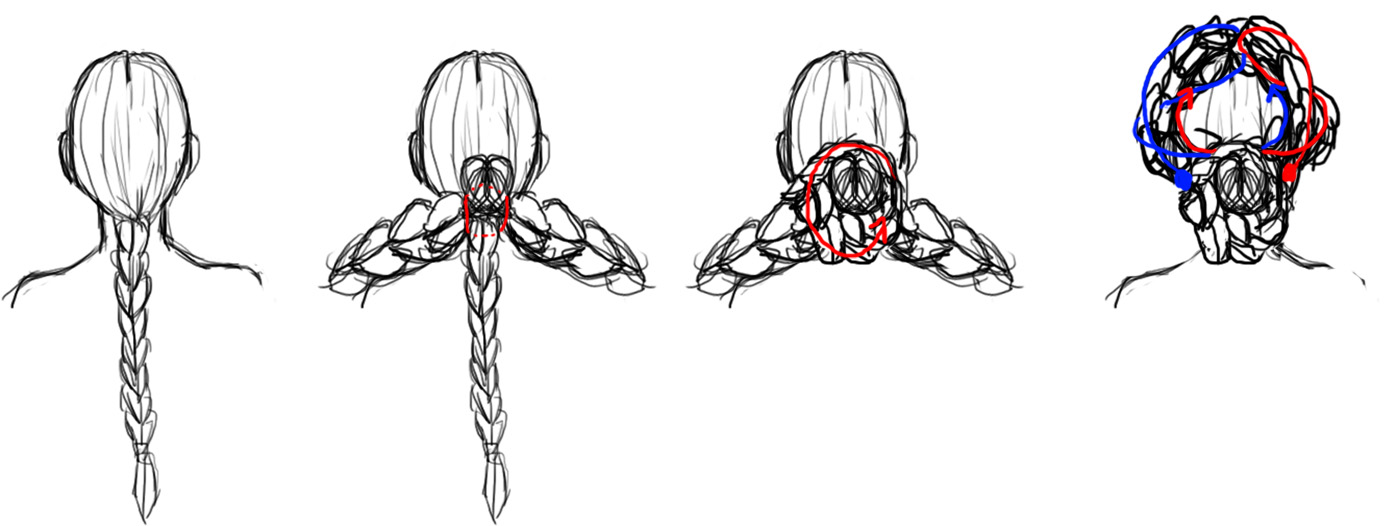
How I did my hairstyle
How I did it:
- I parted my hair in the center and braided my real hair in a low braid.
- I attached the ends of the two braids at the base of my head.
- I wrapped my real hair around the base of the two braids to make a big bun.
- I wrapped up both braids to the top of my head, crossed them over each other and twisted them back down and around the back of my head. I tucked the ends under the top braids and pinned them with bobby pins.
I need some binyeo to help hold the style in place and to decorate it, but I’m happy with the effect I got. The braids could be a bit bigger, but I believe this is appropriate for Goryeo since the hair did not get as big as it did in Joseon.
Sources:
Lee, E-Wha. Korea’s Pastimes and Customs: A Social History. Paramus, NJ: Homa & Sekey, 2006. 147-200. Print.
Lim, Ga-eul. “A Touch of Beauty on Your Hair – The Yonsei Annals.” A Touch of Beauty on Your Hair – The Yonsei Annals. Yonsei University, 1 June 2005. Web. 12 Feb. 2017. <http://annals.yonsei.ac.kr/news/articleView.html?idxno=205>.

